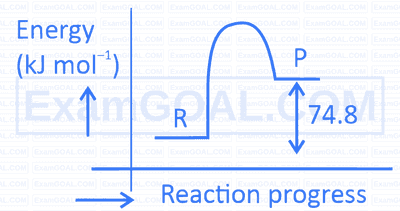
The standard heat of formation, in $\mathrm{kcal} / \mathrm{mol}$ of $\mathrm{Ba}^{2+}$ is : [Given : standard heat of formation of $\mathrm{SO}_4^{2-}$ ion $(\mathrm{aq})=-216 \mathrm{kcal} / \mathrm{mol}$, standard heat of crystallisation of $\mathrm{BaSO}_4(\mathrm{~s})=-4.5 \mathrm{kcal} / \mathrm{mol}$, standard heat of formation of $\left.\mathrm{BaSO}_4(\mathrm{~s})=-349 \mathrm{kcal} / \mathrm{mol}\right]$

Match List-I with List-II
| List - I (Exsample) |
List - II (Type of Solution) |
||
|---|---|---|---|
| A | Humidity | I | Solid in solid |
| B | Alloys | II | Liquid in gas |
| C | Amalgams | III | Solid in gas |
| D | Smoke | IV | Liquid in solid |
Choose the correct answer from the options given below:

$\mathrm{C}(\mathrm{s})+2 \mathrm{H}_2(\mathrm{~g}) \rightarrow \mathrm{CH}_4(\mathrm{~g}) ; \Delta \mathrm{H}=-74.8 \mathrm{~kJ} \mathrm{~mol}^{-1}$. Which of the following diagrams gives an accurate representation of the above reaction? [ $\mathrm{R} \rightarrow$ reactants; $\mathrm{P} \rightarrow$ products]





Sugar ' $X$ '
A. is found in honey
B. is a keto sugar
C. exists in $\alpha$ and $\beta$-anomeric forms.
D. Is laevorotatory.
' X ' is :